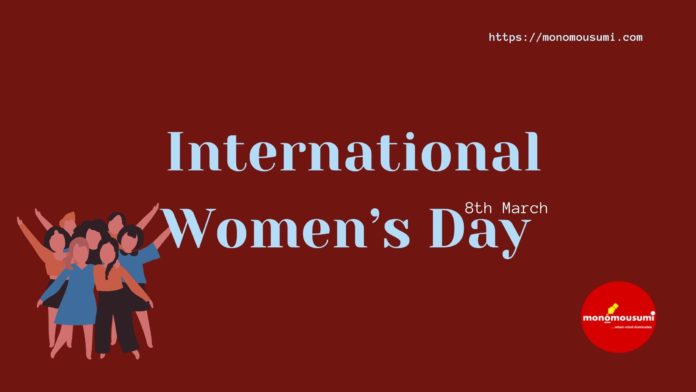It comes as a moral obligation to all women to honor the sacrifices made by their ancestors in order for them to lead better lives. So, International Women’s Day is observed on March 8 every year, which exemplifies the historical journey taken by women all over the world to improve their lives. It serves as a reminder that, while much has been accomplished, there is still much more to be done.
But why an entire day dedicated only to women? History hasn’t been fair to men either. And why the 8th of March? Why not any other day of the year? To answer such questions, one must dive deep into centuries-old events.
It is no secret that women have been severely discriminated against in history. For some unfathomable reason, they were seen as subordinates to men in most parts of the world. With hardly any privileges or rights, their place was seen to be in the homes, raising their children and tending to domestic affairs.
(It’s ludicrous how even centuries later, a large part of this holds true. What’s even worse is that we are in constant denial of the fact. Perhaps, humanity’s greatest failure lies in failing to acknowledge its flaws.)
Of course, now and then a liberal ruler would come along to absolve women from the clutches of a prejudiced society, only to be overthrown by the supporters of the patriarchy in a matter of time. So, then what changed? What eye-opening event occurred that caused people all over the world to see that women should be, though not the same, yet equal to men?
Even though gender disparity gripped all sections of the world, women’s movements first began in the west in the early 19th century. Later, the east, influenced by the west, too sought to break free of the discrimination. Of course, there had been opinions and disagreements before, but no group as a whole had acted upon them. This was primarily due to fear, for the power wielded by those in power was absolute, and the law arbitrary.
Women, as individuals, as well as in political and social clubs, began to demand equal rights and privileges as men, and campaigned for the same. In the beginning, they were seen by people as everything from freaks to terrorists- like all great revolutionaries once were. But as liberalism gained popularity, feminist movements sparked across the globe. Soon, their milestones dotted the world’s timeline.
Within just a few years, the movements had made great strides. Both women and liberal men struggled for (and, more often than not, won) rights to divorce, education, to own property, and to vote for women in various countries. The right to vote was perhaps the most desired privilege, for it not only signified the equality of men and women in politics (a sphere in which, until then, women were seen as unqualified to participate), but it also gave women a chance to speak for themselves.
However, it was also the hardest to achieve. In the US, the suffragette movement continued for more than half a century (1848-1920). It was only in 1920 when the 19th Amendment of the American constitution was ratified, that women won the right to vote nationally.
The suffragette movement started in the UK in 1880 and had continued for 28 years when in 1918 British women over the age of 30 gained the right to vote. In the following years, women belonging to different races would too win the same right.
Even though it was under colonial rule, India too witnessed a women’s suffragette movement in the early 20th century. In the 1920s, women gained limited suffrage rights in various provinces of British India. The Government of India Act 1935 extended these rights, and finally, when the Constitution of free India was adopted in 1950, all women above the age of 18 won full voting rights.
But even though history glorifies these victories, it often fails to mention what was lost; what millions of women had to sacrifice to gain basic human rights. Thousands of women lost their lives, others were separated from their families, and in many countries, women activists were publicly humiliated.
However, even though many people believe the International Women’s Day to have originated from a feminist cause, its real roots lie in the labor movement.
Its seeds were planted in 1908, when 15,000 women marched through New York City seeking reduced work hours, fair wages, and the right to vote. The first National Woman’s Day was proclaimed a year later by the Socialist Party of America.
A woman named Clara Zetkin came up with the notion of making the day international. In 1910, she proposed the concept at a Copenhagen International Conference of Working Women. 100 women, from 17 nations, unanimously agreed to her proposal. It became official when the United Nations (UN) began commemorating the day in 1975.
However, when Clara proposed an International Women’s day, she didn’t have any specific date in mind. It wasn’t established until 1917, when Russian women organized a strike demanding food and peace, the Tsar was forced to abdicate just four days after the strike, and the provisional government granted women the freedom to vote. On the Julian calendar, which was in use in Russia at the time, the women’s strike began on Sunday, February 23. The day was March 8th in the Gregorian calendar, which is when it is commemorated today.
But March 8th isn’t just a day to remember what has been lost and dwell on what has been achieved. It is also a day to acknowledge the disparity and injustice that still exists, and to spread awareness about what we can do to better the situation.
Did you know that even today, on average, women around the world spend more than twice as many hours as men doing unpaid work? Or that 113 countries do not have laws to ensure equal pay for equal work among men and women, while 104 countries make certain jobs off-limits for women? Perhaps you’ll know that young female apprentices earn 21% less than men and struggle to make ends meet. Or maybe that 1 in every 3 women faces some form of physical or sexual assault in her lifetime, a number that has remained almost unchanged over the past decade? These are just a few of the hundreds of shocking (not to mention disappointing) gender inequality statistics.
But this doesn’t mean that change can’t be brought. Even though it is estimated that not even the next generation will live to see gender parity, let alone ours, it won’t do anyone any harm to try. So, let’s use all the measures at our disposal, including activism, advocacy, and nonviolent direct action, to make our voices recognized on these issues and to be the change we wish to see in the world. And even if our electoral system may seem flawed, and even if your one vote may not seem like much, vote. Because in this land where people persistently fail to understand the basic concept of consent, your silence will be falsely claimed as agreement.
Above all, our foremothers wanted us to speak for ourselves. So, let’s make our mark and keep on striving. Who knows, maybe one day we’ll live to see an ‘End of Gender Disparity’ day.
“I raise up my voice- not so I can shout, but so that those without a voice can be heard… we cannot succeed when half of us are held back.” – Malala Yousafzai
By Aradhya Kashyap, Uttar Pradesh















